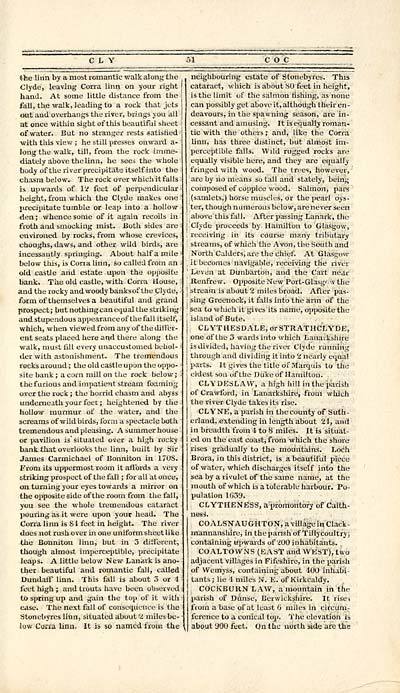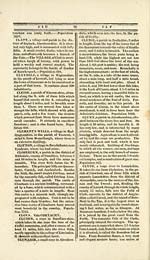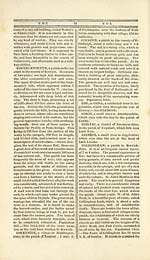Gazetteer of Scotland
(53) Page 51
Download files
Complete book:
Individual page:
Thumbnail gallery: Grid view | List view

C L Y
the linn by a most romantic walk along the
Clyde, leaving Corra linn on your right
hand. At some little distance from the
fall, the walk, leading to a rock that jets
out and overhangs the river, brings you all
at once within sight of this beautiful sheet
of water. But no stranger rests satisfied
with this view ; he still presses onward a-
long the walk, till, from the rock imme-
diately above the linn, he sees the whole
body of the river precipitate itself into the
chasm below. The rock over which it falls
is upwards of 12 feet of perpendicular
height, from which the Clyde makes one
precipitate tumble or leap into a hollow
den ; whence some of it again recoils in
froth and smocking mist. Uoth sides are
environed by rocks, from whose crevices,
choughs, daws, and other wild birds, are
incessantly springing. About half a mile
below this, is Coria linn, so called from an
old castle and estate upon the opposite
bank. The old castle, with Corra House,
and the rocky and woody banksof the Clyde,
form of themselves a beautiful and grand
prospect; but nothing can equal the striking
and stupendous appearanceof the fall itself,
which, when viewed from any of thedilf'er-
ent seats placed here and there along the
walk, must fill every unaccustomed behol-
der with astonishment. The tremendous
rocks around ; the old castle upon the oppo-
site bank ; a corn mill on the rock below;
the furious and impatient stream foaming
over the rock ; the horrid chasm and abyss
underneath your feet ; heightened by the
hollow murmur of the water, and the
screams of wild birds, form a spectacle both
tremendous and pleasing. A summer house
or pavilion is" situated over a high rocky
bank that overlooks the linn, built by Sir
James Carmichaei of Bonniton in 1708.
From its uppermost room it affords a very
striking prospect of the fall ; for all at once,
on turning your eyes towards a mirror on
the opposite side of the room from the fall,
you see the whole tremendous cataract
pouring as it were upon your head. The
Corra linn is S 4 feet in height. The river
does not rush over in one uniform sheet like
the Bonniton linn, but in 5 different,
though almost imperceptible, precipitate
leaps. A little below New Lanark is ano-
ther beautiful and romantic fall, called
Dundaff linn. This fall is about 5 or 4
feel high ; and trouts have been observed
to spring up and gain the top of it with
ease. The next fall of consequence is the
Stonebyrcs linn, situated about 2 miles be-
low Corra linn. It is so named from the
4 C Q_C
neighbouring estate of Stonebyres. This
cataract, which is about SO feet in height,
is the limit of the salmon fishing, as none
can possibly get above it, although t heir en -
deavours, in the spawning season, are in-
cessant and amusing. It is equally roman-
tic with the others ; and, like the Corra
linn, has three distinct, but almost im-
perceptible falls. Wild rugged rocks are
equally visible here, and they are equally
fringed with wood. The trees, however,
are by no means so tall and stately, being
composed of coppice wood. Salmon, pars
(samlets,) horse muscles, or the pearl oys-
ter, though numerous below, are never seen
above this fall. After passing Lanark, the
Clyde proceeds by Hamilton to Glasgow,
receiving in its course many tributary
streams, of which the Avon, the South and
North Calders, are the chief. At Glasgow
it becomes navigable, receiving the river
Leven at Dunbarton, and the Cart near
Renfrew. Opposite New Port- Glasgow the
stream is about 2 miles broad. After pas-
sing Greenock, it falls into the arm of the
sea to which it gives its name, opposite the
island of Bute.
CL YT HESDALE, or STRATHCL YDE,
one of the 3 wards into which Lanarkshire
is divided, having the river Clyde running
through and dividing it into 2 nearly equal
parts. It gives the title of Marquis to the
eldest son of the Duke of Hamilton.
CLY DESLAW, a high hill in the parish
of Crawford, in Lanarkshire, from which
the river Clyde takes its rise.
CLVNE, a parish in the county of Suth-
erland, extending in length about 24, and
in breadth from 4 to 8 miles. It is situat-
ed on the east coast, from which the shore
rises gradually to the mountains. Loch
Brora, in this district, is a beautiful piece
of water, which discharges itself into the
sea by a rivulet of the same name, at the
mouth of which is a tolerable harbour. Po-
pulation 1639.
CLYTHENESS, a promontory of Caith-
ness.
COALSNAUGHTON, a village in Clack-
mannanshire, in thepansh of Tillycoultry,
containing upwards of 200 inhabitants.
COALTOWNS (EAST and WEST), two
adjacent villages in Fifeshire, in the parish
of Wcmyss, containing about 400 inhabi-
tants ; lie 4 miles N. E. of Kirkcaldy.
COCKBURN LAW, a mountain in the
parish of Dunse, Berwickshire. It rises
from a base of at least 6 miles in circum-
ference to a conical top. The elevation is
about t>00 feet. On the north side are the
the linn by a most romantic walk along the
Clyde, leaving Corra linn on your right
hand. At some little distance from the
fall, the walk, leading to a rock that jets
out and overhangs the river, brings you all
at once within sight of this beautiful sheet
of water. But no stranger rests satisfied
with this view ; he still presses onward a-
long the walk, till, from the rock imme-
diately above the linn, he sees the whole
body of the river precipitate itself into the
chasm below. The rock over which it falls
is upwards of 12 feet of perpendicular
height, from which the Clyde makes one
precipitate tumble or leap into a hollow
den ; whence some of it again recoils in
froth and smocking mist. Uoth sides are
environed by rocks, from whose crevices,
choughs, daws, and other wild birds, are
incessantly springing. About half a mile
below this, is Coria linn, so called from an
old castle and estate upon the opposite
bank. The old castle, with Corra House,
and the rocky and woody banksof the Clyde,
form of themselves a beautiful and grand
prospect; but nothing can equal the striking
and stupendous appearanceof the fall itself,
which, when viewed from any of thedilf'er-
ent seats placed here and there along the
walk, must fill every unaccustomed behol-
der with astonishment. The tremendous
rocks around ; the old castle upon the oppo-
site bank ; a corn mill on the rock below;
the furious and impatient stream foaming
over the rock ; the horrid chasm and abyss
underneath your feet ; heightened by the
hollow murmur of the water, and the
screams of wild birds, form a spectacle both
tremendous and pleasing. A summer house
or pavilion is" situated over a high rocky
bank that overlooks the linn, built by Sir
James Carmichaei of Bonniton in 1708.
From its uppermost room it affords a very
striking prospect of the fall ; for all at once,
on turning your eyes towards a mirror on
the opposite side of the room from the fall,
you see the whole tremendous cataract
pouring as it were upon your head. The
Corra linn is S 4 feet in height. The river
does not rush over in one uniform sheet like
the Bonniton linn, but in 5 different,
though almost imperceptible, precipitate
leaps. A little below New Lanark is ano-
ther beautiful and romantic fall, called
Dundaff linn. This fall is about 5 or 4
feel high ; and trouts have been observed
to spring up and gain the top of it with
ease. The next fall of consequence is the
Stonebyrcs linn, situated about 2 miles be-
low Corra linn. It is so named from the
4 C Q_C
neighbouring estate of Stonebyres. This
cataract, which is about SO feet in height,
is the limit of the salmon fishing, as none
can possibly get above it, although t heir en -
deavours, in the spawning season, are in-
cessant and amusing. It is equally roman-
tic with the others ; and, like the Corra
linn, has three distinct, but almost im-
perceptible falls. Wild rugged rocks are
equally visible here, and they are equally
fringed with wood. The trees, however,
are by no means so tall and stately, being
composed of coppice wood. Salmon, pars
(samlets,) horse muscles, or the pearl oys-
ter, though numerous below, are never seen
above this fall. After passing Lanark, the
Clyde proceeds by Hamilton to Glasgow,
receiving in its course many tributary
streams, of which the Avon, the South and
North Calders, are the chief. At Glasgow
it becomes navigable, receiving the river
Leven at Dunbarton, and the Cart near
Renfrew. Opposite New Port- Glasgow the
stream is about 2 miles broad. After pas-
sing Greenock, it falls into the arm of the
sea to which it gives its name, opposite the
island of Bute.
CL YT HESDALE, or STRATHCL YDE,
one of the 3 wards into which Lanarkshire
is divided, having the river Clyde running
through and dividing it into 2 nearly equal
parts. It gives the title of Marquis to the
eldest son of the Duke of Hamilton.
CLY DESLAW, a high hill in the parish
of Crawford, in Lanarkshire, from which
the river Clyde takes its rise.
CLVNE, a parish in the county of Suth-
erland, extending in length about 24, and
in breadth from 4 to 8 miles. It is situat-
ed on the east coast, from which the shore
rises gradually to the mountains. Loch
Brora, in this district, is a beautiful piece
of water, which discharges itself into the
sea by a rivulet of the same name, at the
mouth of which is a tolerable harbour. Po-
pulation 1639.
CLYTHENESS, a promontory of Caith-
ness.
COALSNAUGHTON, a village in Clack-
mannanshire, in thepansh of Tillycoultry,
containing upwards of 200 inhabitants.
COALTOWNS (EAST and WEST), two
adjacent villages in Fifeshire, in the parish
of Wcmyss, containing about 400 inhabi-
tants ; lie 4 miles N. E. of Kirkcaldy.
COCKBURN LAW, a mountain in the
parish of Dunse, Berwickshire. It rises
from a base of at least 6 miles in circum-
ference to a conical top. The elevation is
about t>00 feet. On the north side are the
Set display mode to: Large image | Transcription
Images and transcriptions on this page, including medium image downloads, may be used under the Creative Commons Attribution 4.0 International Licence unless otherwise stated. ![]()
| Gazetteers of Scotland, 1803-1901 > Gazetteer of Scotland > (53) Page 51 |
|---|
| Permanent URL | https://digital.nls.uk/97422330 |
|---|

